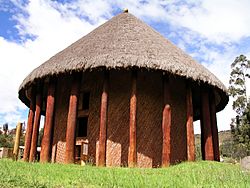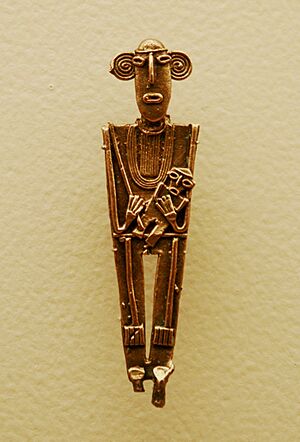Chiminigagua facts for kids
Quick facts for kids Chiminigagua |
|
|---|---|
| Supreme being Creator of the world |
|
| Member of Muisca religion | |

Sun Temple, place of worship to Chiminigagua
|
|
| Other names | Chiminichagua, Chimichagua |
| Affiliation | Bachué, Bochica |
| Region | Altiplano Cundiboyacense |
| Ethnic group | muisca |
| Offspring | Chía, Sué, Cuchavira |
| Greek equivalent | Zeus |
| Roman equivalent | Jupiter |
| Christian equivalent | God |
| Hinduism equivalent | Vishnu |

Chiminigagua, also known as Chiminichagua or Chimichagua, was the most powerful god for the Muisca people. He was their supreme being and the creator of the entire world. The Muisca lived in what is now Colombia. They were one of the advanced civilizations in the Americas. They developed their unique religion in the Altiplano Cundiboyacense, a high plateau in the Andes mountains.
Contents
Chiminigagua: The Creator of Light
Chiminigagua was seen as a good god. He was the only source of light when the world was just darkness. The Muisca believed that before creation, there was only night. Chiminigagua was the only light in this dark world.
How the World Began: The Creation Story
When Chiminigagua decided to bring light to the Universe, he first opened his huge belly. Bright light shone out from it. Then, he created two large black birds. He sent these birds flying into space. As the birds flew, they spread light from their beaks. This act created all the light in the Universe. This is how Chiminigagua made light and everything else in the world.
Chiminigagua also created other important gods. These included Chía (the Moon), Sué (the Sun), and Cuchavira (the rainbow). For the Muisca, worshipping the Moon and the Sun was a way to praise Chiminigagua. The creation of the Sun and Moon also led to the birth of the mother goddess Bachué.
Worshipping Chiminigagua
The Muisca believed in a supreme being and worshipped the Sun. This is similar to many other indigenous peoples around the world. For example, the Aztecs had Tezcatlipoca. The Incas worshipped Viracocha. Many ancient cultures had sun gods, like the Egyptians with Ra and the Greeks with Helios.
The Muisca built important places of worship. These were in cities like Sogamoso, Guatavita, and Bogotá. In Tunja, a ruler named Goranchacha built a temple. People placed two circular stones there, called the Cojines del zaque (Zaque Pillows).
Daily Rituals and Offerings
Every day before sunrise, the Muisca ruler, priests, and people gathered at these stones. They prayed for the Sun to rise in the east. This gave power to the astronomers during events like eclipses. The Muisca ruler would kneel on the Pillows. The people would pray, sing, and dance. Sometimes, as part of their rituals, children were offered to the holy Sun.
Sogamoso was a very special city. It was known as the "City of the Sun." Many pilgrims traveled there to worship Chiminigagua.
The Spanish Arrival
When Spanish conquistadors, led by Gonzalo Jiménez de Quesada, arrived, they were looking for gold. They also searched for the legendary city of El Dorado. Sadly, their torches accidentally burned down the sacred Sun Temple in Sogamoso. This destroyed one of the Muisca's most beautiful religious buildings. Today, a reconstructed Sun Temple can be seen in the Archeology Museum of Sogamoso.
Spanish writers like Pedro Simón and Juan de Castellanos wrote about Chiminigagua in the late 1500s. They described him as a powerful god without a physical body. He ruled over all other gods. However, the Muisca did not worship Chiminigagua directly. Instead, they honored him through his lesser gods like the Sun, Moon, and fertility gods. Bochica was considered Chiminigagua's messenger god. When the Spanish arrived, the Muisca sometimes called them "children of the Sun."

